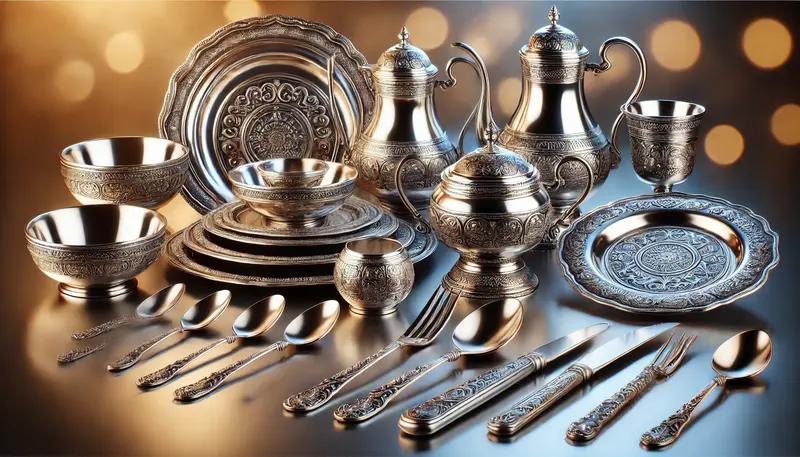Have you ever come across the term “German silver” and wondered what it is? Despite its shiny, silvery appearance, it’s not what most people think. German silver, also known as nickel silver, is a fascinating material with a unique history and many uses. Whether you’re a fan of antiques, an artist, or just someone curious about shiny things, this blog will give you everything you need to know about German silver.
In this post, we’ll cover:
- What German silver is made of
- Why it’s called “German silver” (spoiler: it’s not silver)
- Its history and origins
- Common uses and benefits
- How to care for German silver
- FAQs to answer your burning questions
Let’s dive in!
What Is German Silver?
First things first: German silver is not real silver. It’s an alloy made from a mixture of copper, zinc, and nickel. These metals come together to create a material that looks like silver but doesn’t contain a single speck of the real thing.
The percentages of these metals can vary, but typically:
- Copper: 50–60%
- Zinc: 20–30%
- Nickel: 10–20%
This mix gives German silver its shiny, metallic finish and makes it durable, corrosion-resistant, and versatile.
Why Is It Called “German Silver”?
The name “German silver” comes from its origins in Germany during the early 19th century. It was developed as a cheaper alternative to real silver, which was (and still is) very expensive. At first, it was primarily used for decorative items, jewelry, and cutlery.
Over time, the material gained popularity worldwide, but the name stuck—even though it often confuses people who think it’s related to real silver. To avoid misunderstanding, it’s also called nickel silver or white metal.
A Brief History of German Silver
The story of German silver begins in China, where artisans in the 17th century created a similar alloy known as paktong or white copper. German metallurgists later studied this material and developed their own version, which became what we now know as German silver.
By the 19th century, the alloy was widely adopted across Europe and the United States, especially during the Industrial Revolution. Manufacturers loved its affordability and resemblance to silver, making it a hit in industries like tableware, musical instruments, and even currency.
Common Uses of German Silver
German silver is incredibly versatile. Thanks to its shiny finish, strength, and corrosion resistance, it’s used in a wide range of products. Here are some of the most common uses:
1. Jewelry
German silver is a popular choice for jewelry makers because it mimics the look of silver at a fraction of the cost. You’ll find it in necklaces, earrings, bracelets, and more. Artists also love it for its ability to hold intricate designs.
2. Cutlery and Tableware
From forks and spoons to decorative trays, German silver is widely used in making tableware. It’s lightweight, easy to clean, and adds a touch of elegance to dining.
3. Musical Instruments
Did you know that German silver is used in flutes, trumpets, and saxophones? The alloy enhances sound quality and ensures durability, making it a favorite in the music world.
4. Crafts and Décor
Artisans use German silver for everything from sculptures to picture frames. Its shiny appearance makes it ideal for decorative purposes.
5. Electrical Components
Because of its conductivity, German silver is also used in electrical engineering for items like resistors and connectors.
Benefits of German Silver
So why is German silver so popular? Here are some of its key benefits:
- Affordable Alternative: It looks like silver but costs much less.
- Durable: It’s resistant to corrosion, tarnish, and wear.
- Lightweight: Easy to handle, especially for jewelry and crafts.
- Malleable: Perfect for intricate designs and detailed work.
- Versatile: Suitable for everything from music to tableware.
How to Care for German Silver
To keep your German silver items looking shiny and beautiful, follow these simple care tips:
- Clean Regularly: Wipe with a soft cloth to remove dirt and fingerprints.
- Avoid Harsh Chemicals: Use mild soap and water instead of abrasive cleaners.
- Polish Occasionally: Use a non-abrasive metal polish to maintain its shine.
- Store Properly: Keep items in a dry place to prevent moisture damage.
By taking good care of your German silver, you can enjoy its beauty for years to come.
Frequently Asked Questions (FAQs)
1. Is German silver the same as sterling silver?
No, German silver is not the same as sterling silver. While sterling silver is made of 92.5% real silver, German silver contains no silver at all. It’s an alloy of copper, zinc, and nickel.
2. Is German silver safe to use?
Yes, German silver is generally safe to use. However, some people may have a sensitivity to nickel, so avoid prolonged contact if you’re allergic.
3. Does German silver tarnish?
German silver is resistant to tarnishing, but it can develop a dull finish over time. Regular cleaning and polishing can help maintain its shine.
4. How can I tell if something is German silver?
Look for markings or stamps on the item. German silver is often labeled as “nickel silver” or “alpaca.” If you’re unsure, a jeweler or expert can help identify it.
5. Is German silver valuable?
While it’s not as valuable as real silver, German silver still holds value for its durability, beauty, and craftsmanship.
Conclusion
German silver may not be real silver, but it’s a real gem in its own right. This versatile, affordable alloy has been a favorite for centuries, and its uses range from jewelry to musical instruments. Whether you’re looking to buy, create, or simply admire German silver, now you know all about its history, composition, and care.
So next time you see something shiny that’s labeled “German silver,” you’ll know exactly what it is—and appreciate the craftsmanship behind it. Happy exploring!





Leave a Reply